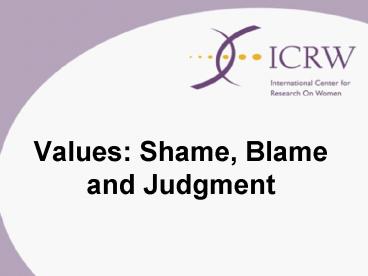Values: Shame, Blame and Judgment - PowerPoint PPT Presentation
1 / 8
Title:
Values: Shame, Blame and Judgment
Description:
Percent of Respondents Agreeing and. Perceptions of Community Responses to ... 1. Shame: 50% of respondents agreed to at least one of the 3 items ... – PowerPoint PPT presentation
Number of Views:70
Avg rating:3.0/5.0
Title: Values: Shame, Blame and Judgment
1
Values Shame, Blame and Judgment
2
Moral values and HIV/AIDS Stigma
- The tendency to associate moral impropriety to
HIV/AIDS leads to stigmatization of PLHAs. - Many stigma reduction interventions aim to change
attitudes that associate moral impropriety to
HIV/AIDS. - However changing moral-based attitudes is a
challenging and sensitive issue. Achievement of
changes takes time.
3
Commonly used Indicators
- Percent of people who would judge or blame
persons living with HIV/AIDS for their illness - Percent of people who would feel shame if they
associated with a person living with HIV/AIDS
Each indicator is constructed using several
items/questions The Tanzania team field-tested
these indicators
4
Percent of Respondents Agreeing and Perceptions
of Community Responses to Stigmatizing
Attitudinal Statements
5
Construction of two Indicators
6
Items Selected
- Shame
- I would feel ashamed if I were infected with
HIV/AIDS - I would feel ashamed if someone in my family had
HIV/AIDS - People with HIV/AIDS should be ashamed of
themselves - Judgment and Blame
- People with HIV/AIDS are promiscuous
- It is women prostitutes who spread HIV in the
community - HIV/AIDS is a punishment from God
7
Recommendations from field-testing
- Indicators are needed for two dimensions shame
and blame/judgment - Construction of each indicator needs at least
three items. - Omit positive attitudinal questions/items, they
do not show adequate variations to support
analysis.
8
Progress made, but more work needed..
- The 3-items recommended indicators capture
value-based stigma and can be adapted to measure
this stigma in different populations to monitor
progress of programs. - Further careful phrasing of the stigmatizing
statements is needed to differentiate the reality
that may underlie spread of infection from the
general stigmatization of MARPs.































